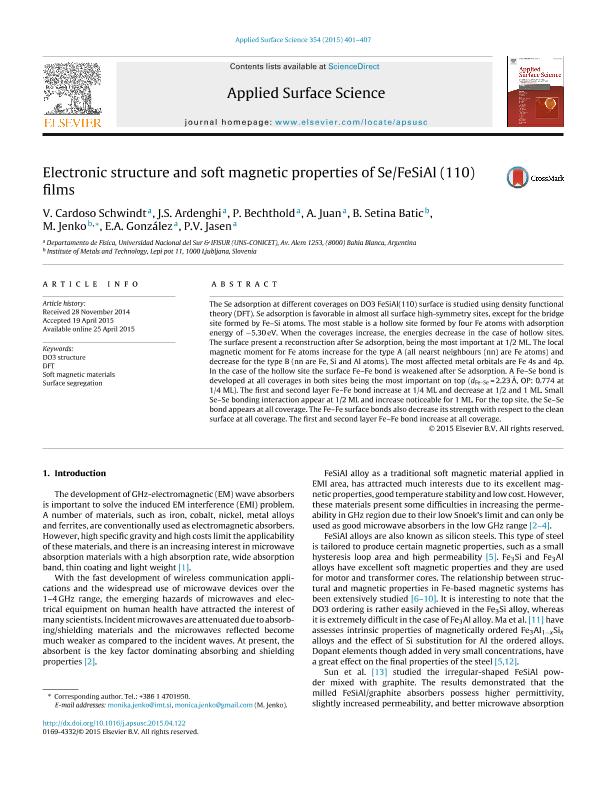Mostrar el registro sencillo del ítem
dc.contributor.author
Cardoso Schwindt, Virginia Araceli

dc.contributor.author
Ardenghi, Juan Sebastian

dc.contributor.author
Bechthold, Pablo Ignacio

dc.contributor.author
Juan, Alfredo

dc.contributor.author
Setina Batic, Barbara
dc.contributor.author
Jenko, Monika
dc.contributor.author
Gonzalez, Estela Andrea

dc.contributor.author
Jasen, Paula Verónica

dc.date.available
2021-12-13T05:15:43Z
dc.date.issued
2015-11-01
dc.identifier.citation
Cardoso Schwindt, Virginia Araceli; Ardenghi, Juan Sebastian; Bechthold, Pablo Ignacio; Juan, Alfredo; Setina Batic, Barbara; et al.; Electronic structure and soft magnetic properties of Se/FeSiAl (110) films; Elsevier Science; Applied Surface Science; 354; 1-11-2015; 401-407
dc.identifier.issn
0169-4332
dc.identifier.uri
http://hdl.handle.net/11336/148567
dc.description.abstract
The Se adsorption at different coverages on DO3 FeSiAl(110) surface is studied using density functional theory (DFT). Se adsorption is favorable in almost all surface high-symmetry sites, except for the bridge site formed by Fe–Si atoms. The most stable is a hollow site formed by four Fe atoms with adsorption energy of −5.30 eV. When the coverages increase, the energies decrease in the case of hollow sites. The surface present a reconstruction after Se adsorption, being the most important at 1/2 ML. The local magnetic moment for Fe atoms increase for the type A (all nearst neighbours (nn) are Fe atoms) and decrease for the type B (nn are Fe, Si and Al atoms). The most affected metal orbitals are Fe 4s and 4p. In the case of the hollow site the surface Fe–Fe bond is weakened after Se adsorption. A Fe–Se bond is developed at all coverages in both sites being the most important on top (dFe–Se = 2.23 Å, OP: 0.774 at 1/4 ML). The first and second layer Fe–Fe bond increase at 1/4 ML and decrease at 1/2 and 1 ML. Small Se–Se bonding interaction appear at 1/2 ML and increase noticeable for 1 ML. For the top site, the Se–Se bond appears at all coverage. The Fe–Fe surface bonds also decrease its strength with respect to the clean surface at all coverage. The first and second layer Fe–Fe bond increase at all coverage.
dc.format
application/pdf
dc.language.iso
eng
dc.publisher
Elsevier Science

dc.rights
info:eu-repo/semantics/openAccess
dc.rights.uri
https://creativecommons.org/licenses/by-nc-sa/2.5/ar/
dc.subject
DO3 STRUCTURE
dc.subject
DFT
dc.subject
SOFT MAGNETIC
dc.subject
SURFACE SEGREGATION
dc.subject.classification
Física de los Materiales Condensados

dc.subject.classification
Ciencias Físicas

dc.subject.classification
CIENCIAS NATURALES Y EXACTAS

dc.title
Electronic structure and soft magnetic properties of Se/FeSiAl (110) films
dc.type
info:eu-repo/semantics/article
dc.type
info:ar-repo/semantics/artículo
dc.type
info:eu-repo/semantics/publishedVersion
dc.date.updated
2020-08-04T19:11:52Z
dc.journal.volume
354
dc.journal.pagination
401-407
dc.journal.pais
Países Bajos

dc.journal.ciudad
Amsterdam
dc.description.fil
Fil: Cardoso Schwindt, Virginia Araceli. Universidad Nacional del Sur. Departamento de Física; Argentina. Consejo Nacional de Investigaciones Científicas y Técnicas. Centro Científico Tecnológico Conicet - Bahía Blanca. Instituto de Física del Sur. Universidad Nacional del Sur. Departamento de Física. Instituto de Física del Sur; Argentina
dc.description.fil
Fil: Ardenghi, Juan Sebastian. Consejo Nacional de Investigaciones Científicas y Técnicas. Centro Científico Tecnológico Conicet - Bahía Blanca. Instituto de Física del Sur. Universidad Nacional del Sur. Departamento de Física. Instituto de Física del Sur; Argentina. Universidad Nacional del Sur. Departamento de Física; Argentina
dc.description.fil
Fil: Bechthold, Pablo Ignacio. Consejo Nacional de Investigaciones Científicas y Técnicas. Centro Científico Tecnológico Conicet - Bahía Blanca. Instituto de Física del Sur. Universidad Nacional del Sur. Departamento de Física. Instituto de Física del Sur; Argentina. Universidad Nacional del Sur. Departamento de Física; Argentina
dc.description.fil
Fil: Juan, Alfredo. Universidad Nacional del Sur. Departamento de Física; Argentina. Consejo Nacional de Investigaciones Científicas y Técnicas. Centro Científico Tecnológico Conicet - Bahía Blanca. Instituto de Física del Sur. Universidad Nacional del Sur. Departamento de Física. Instituto de Física del Sur; Argentina
dc.description.fil
Fil: Setina Batic, Barbara. Institute of Metals and Technology; Eslovenia
dc.description.fil
Fil: Jenko, Monika. Institute of Metals and Technology; Eslovenia
dc.description.fil
Fil: Gonzalez, Estela Andrea. Universidad Nacional del Sur. Departamento de Física; Argentina. Consejo Nacional de Investigaciones Científicas y Técnicas. Centro Científico Tecnológico Conicet - Bahía Blanca. Instituto de Física del Sur. Universidad Nacional del Sur. Departamento de Física. Instituto de Física del Sur; Argentina
dc.description.fil
Fil: Jasen, Paula Verónica. Universidad Nacional del Sur. Departamento de Física; Argentina. Consejo Nacional de Investigaciones Científicas y Técnicas. Centro Científico Tecnológico Conicet - Bahía Blanca. Instituto de Física del Sur. Universidad Nacional del Sur. Departamento de Física. Instituto de Física del Sur; Argentina
dc.journal.title
Applied Surface Science

dc.relation.alternativeid
info:eu-repo/semantics/altIdentifier/url/http://www.sciencedirect.com/science/article/pii/S0169433215009721
dc.relation.alternativeid
info:eu-repo/semantics/altIdentifier/doi/http://dx.doi.org/10.1016/j.apsusc.2015.04.122
Archivos asociados
